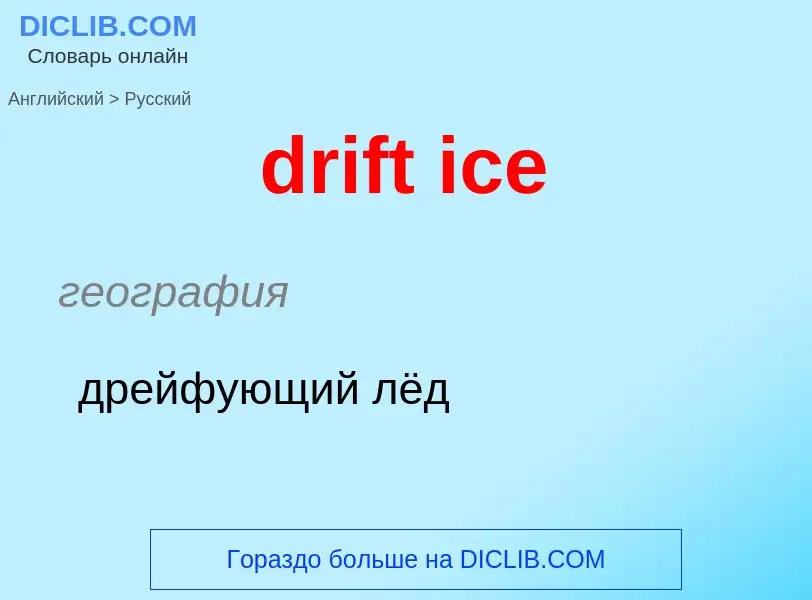Vertaling en analyse van woorden door kunstmatige intelligentie ChatGPT
Op deze pagina kunt u een gedetailleerde analyse krijgen van een woord of zin, geproduceerd met behulp van de beste kunstmatige intelligentietechnologie tot nu toe:
- hoe het woord wordt gebruikt
- gebruiksfrequentie
- het wordt vaker gebruikt in mondelinge of schriftelijke toespraken
- opties voor woordvertaling
- Gebruiksvoorbeelden (meerdere zinnen met vertaling)
- etymologie
drift ice - vertaling naar russisch
география
дрейфующий лёд
Definitie
Wikipedia

Drift ice, also called brash ice, is sea ice that is not attached to the shoreline or any other fixed object (shoals, grounded icebergs, etc.). Unlike fast ice, which is "fastened" to a fixed object, drift ice is carried along by winds and sea currents, hence its name. When drift ice is driven together into a large single mass (>70% coverage), it is called pack ice. Wind and currents can pile up that ice to form ridges up to dozens of metres in thickness. These represent a challenge for icebreakers and offshore structures operating in cold oceans and seas.
Drift ice consists of ice floes, individual pieces of sea ice 20 metres (66 ft) or more across. Floes are classified according to size: small – 20 metres (66 ft) to 100 metres (330 ft); medium – 100 metres (330 ft) to 500 metres (1,600 ft); big – 500 metres (1,600 ft) to 2,000 metres (6,600 ft); vast – 2 kilometres (1.2 mi) to 10 kilometres (6.2 mi); and giant – more than 10 kilometres (6.2 mi).
Drift ice affects:
- Security of navigation
- Climatic impact (see Polar ice packs)
- Geological impact
- Biosphere influence (see Ecology of sea ice)
Drift ice can exert tremendous forces when rammed against structures, and can shear off rudders and propellers from ships and strong structures anchored to the shore, such as piers. These structures must be retractable or removable to avoid damage. Similarly, ships can get stuck between drift ice floes.
The two major ice packs are the Arctic ice pack and the Antarctic ice pack. The most important areas of pack ice are the polar ice packs formed from seawater in the Earth's polar regions: the Arctic ice pack of the Arctic Ocean and the Antarctic ice pack of the Southern Ocean. Polar packs significantly change their size during seasonal changes of the year. Because of vast amounts of water added to or removed from the oceans and atmosphere, the behavior of polar ice packs has a significant impact on global changes in climate.
Seasonal ice drift in the Sea of Okhotsk by the northern coast of Hokkaidō, Japan, has become a tourist attraction, and is one of the 100 Soundscapes of Japan. The Sea of Okhotsk is the southernmost area in the Northern Hemisphere where drift ice may be observed.


![''Kontio'']], which in this picture became stuck in drift ice while towing a cargo ship in pack ice in the northern [[Baltic sea]] ''Kontio'']], which in this picture became stuck in drift ice while towing a cargo ship in pack ice in the northern [[Baltic sea]]](https://commons.wikimedia.org/wiki/Special:FilePath/Kontio towing.jpg?width=200)
![[[Ice floe]]s / pack ice [[Ice floe]]s / pack ice](https://commons.wikimedia.org/wiki/Special:FilePath/IceNomenclature-2LightPack.jpg?width=200)
![[[Satellite image]] of drift ice in the [[Arctic Ocean]] around [[Wrangel Island]] [[Satellite image]] of drift ice in the [[Arctic Ocean]] around [[Wrangel Island]]](https://commons.wikimedia.org/wiki/Special:FilePath/Wrangelisland.jpg?width=200)
![Drift ice in the [[Sea of Okhotsk]] Drift ice in the [[Sea of Okhotsk]]](https://commons.wikimedia.org/wiki/Special:FilePath/Icebreaker Aurora on drift ice at Sea of Okhost.jpg?width=200)

